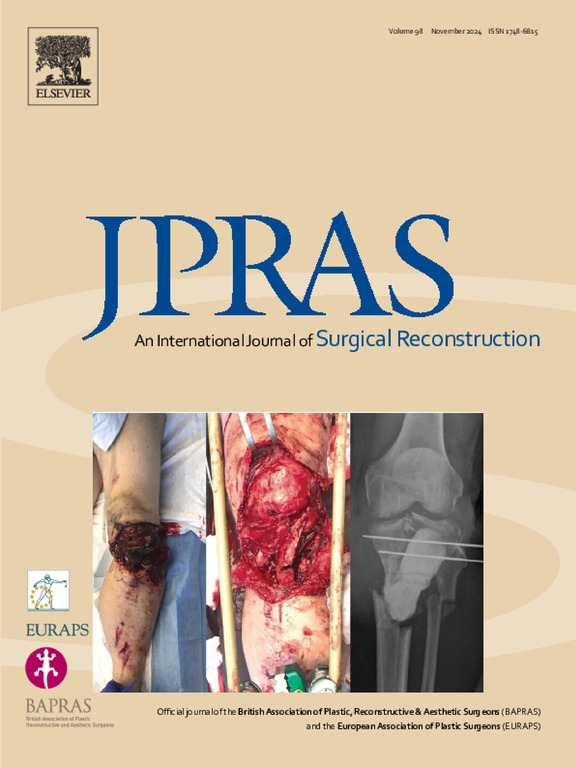两阶段前乳房重建:综合回顾和荟萃分析
IF 2
3区 医学
Q2 SURGERY
Journal of Plastic Reconstructive and Aesthetic Surgery
Pub Date : 2025-02-25
DOI:10.1016/j.bjps.2025.02.041
引用次数: 0
摘要
背景基于植物的乳房重建是乳房切除术后最常用的乳房重建方法。假体乳房重建有助于在减少手术时间的情况下获得最佳效果,在选定的患者中,比直接植入假体和胸下重建具有优势。本研究旨在提供两阶段前乳房重建的全面概述。方法进行系统文献检索,并在PubMed、Cochrane和Embase数据库中按照系统评价和元分析指南的首选报告项目进行检索。纳入标准包括临床试验或随机临床试验相关的完成两阶段前乳房重建。通过统计分析综合资料并评价结果。结果共纳入48篇文献,评估4461例患者和3894个乳房。最常见的乳房切除术类型是皮肤保留乳房切除术,其次是乳头乳晕复合体保留乳房切除术。第一步手术时,平均组织扩张器大小为423.64 cc,最终平均扩张器填充为349.10 cc。第一和第二阶段手术的平均时间为6.21个月,平均随访时间为17.10个月。21.27%的患者至少出现一种并发症。其中,血清肿占11.19%,感染占8.97%,皮瓣坏死占8.48%,包膜挛缩占6.74%,波纹/起皱占11.30%,扩张器或种植体暴露占2.38%,种植体移除占8.62%。结论两期前乳房重建术是一种可行的手术选择。最常见的并发症是血清肿。辅助放疗与较高的感染和种植体移除率相关。本文章由计算机程序翻译,如有差异,请以英文原文为准。
Two-stage prepectoral breast reconstruction: A comprehensive review and meta-analysis
Background
Implant-based breast reconstruction is the most used approach for breast reconstruction following mastectomy. Prosthetic breast reconstruction helps achieve optimal results with reduced operation time, offering advantages over direct-to-implant and subpectoral reconstruction in selected patients. This study aimed to provide a comprehensive overview of the two-stage prepectoral breast reconstruction.
Methods
A systematic literature search was performed, and the search was conducted across the PubMed, Cochrane, and Embase databases by adhering to the preferred reporting items for systematic reviews and meta-analysis guidelines. The inclusion criteria encompassed clinical trials or randomized clinical trials related to completed two-stage prepectoral breast reconstruction. Statistical analyses were conducted to synthesize the data and evaluate outcomes.
Results
A total of 48 articles were included for analysis, evaluating 4461 patients and 3894 breasts. The most commonly performed mastectomy type was skin-sparing mastectomy, followed by nipple-areola complex-sparing mastectomy. For the first surgical step, the mean tissue expander size was 423.64 cc, with a mean final expander fill of 349.10 cc. The mean time between the first and second surgery stages was 6.21 months, and the mean follow-up time was 17.10 months. A total of 21.27% of the patients experienced at least one complication. Specifically, seroma was identified in 11.19%, infection in 8.97%, skin flap necrosis in 8.48%, capsular contracture in 6.74%, rippling/wrinkling in 11.30%, expander or implant exposure in 2.38%, and implant removal in 8.62% of the patients.
Conclusions
Two-stage prepectoral breast reconstruction is a viable surgical option for selected patients. The most frequent complication was seroma. Adjuvant radiotherapy was associated with a higher rate of infection and implant removal.
求助全文
通过发布文献求助,成功后即可免费获取论文全文。
去求助
来源期刊
CiteScore
3.10
自引率
11.10%
发文量
578
审稿时长
3.5 months
期刊介绍:
JPRAS An International Journal of Surgical Reconstruction is one of the world''s leading international journals, covering all the reconstructive and aesthetic aspects of plastic surgery.
The journal presents the latest surgical procedures with audit and outcome studies of new and established techniques in plastic surgery including: cleft lip and palate and other heads and neck surgery, hand surgery, lower limb trauma, burns, skin cancer, breast surgery and aesthetic surgery.

 求助内容:
求助内容: 应助结果提醒方式:
应助结果提醒方式:


